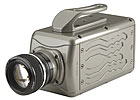Today's automated assembly systems move so fast that when something goes wrong, the cause of the problem is invisible to the unaided eye. Learn how high-speed digital video can help.

At a resolution of 1,024 by 1,024 pixels, this high-speed digital video camera can shoot 1,200 pictures per second. At a resolution of 512 by 512 pixels, it can take 3,800 pictures per second. When played back at a standard frame rate of 25 pictures per second, movement captured at the latter speed would appear 152 times slower than reality. Photo courtesy Vision Research Inc.
These systems move so fast, in fact, that when something goes wrong, the cause of the problem might come and go literally in the blink of an eye. That’s when a high-speed digital video camera becomes invaluable.
“When it’s too fast to see and too important not to, you need a high-speed digital camera,” says Rick Robinson, director of marketing at Vision Research Inc. (Wayne, NJ). “Assembly and packaging equipment runs at very high speeds-hundreds or even thousands of cycles per minute. At those speeds, it’s not uncommon for something to bend or go out of tolerance. As a result, the machine no longer functions at peak efficiency. Yet, when you slow the machine down to get a better look at the problem, it starts working normally. When you turn it back up, it’s broken again.
“Our cameras let you look at the machine in slow motion while it’s running at full speed, so you can see what’s going on. You can see details that you cannot see at regular speed.”
Ordinarily, video is shot and played at a rate of 24 to 30 frames per second. High-speed cameras take images at a much higher rate-hundreds, thousands or even hundreds of thousands of frames per second. Later this month, Vision Research will release a camera that can shoot 1 million frames per second. When high-speed video is played back at the normal rate, it appears magnitudes slower than reality.
“A high-speed digital video camera is no different than a digital still camera, except that instead of taking one picture per second, it takes thousands per second,” explains Robinson. “It takes a still image and stores it in memory, takes another, stores it in memory.”
Another key difference is in how the images get out of the camera. The sensor is designed to output a large number of images quickly. “It’s analogous to a football stadium,” says Robinson. “A stadium with 30 or 50 exit doors will empty much faster than a stadium with just one. The camera is designed so data gets off the sensor as rapidly as possible, so it’s ready to take the next picture in a matter of microseconds or nanoseconds.”
Besides analyzing the performance of fast-moving machinery, engineers use high-speed video as an aid to product design. For example, defense contractors use high-speed video to analyze the performance of shaped explosives or bullet-proof glass. Electronics engineers use high-speed video to review the results of drop tests of cell phones and other portable devices. “They can see how the product reacts when it’s dropped,” says Robinson. “Where does it bend? If it cracks, where does the crack start? Then, they can redesign the product to give it greater survivability.”
Because the camera sensor has so little time to gather light, adequate illumination and a good lens are critical. “Fast lenses, which filter out very little light, may be necessary,” says Robinson.
A tripod or other support also may be necessary. “A handheld camera can be used for taking pictures at 1,000 to 2,000 frames per second,” says Robinson. “As you go faster, the slightest vibration can interfere with the image.”
When choosing a high-speed camera, engineers should remember that there’s a trade-off between speed and resolution. The higher the resolution, the slower the frame rate. At a resolution of 1,024 by 1,024 pixels, a camera might shoot 1,200 pictures per second. At a resolution of 512 by 512 pixels, the same camera can take 3,800 pictures per second.



